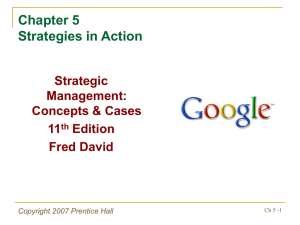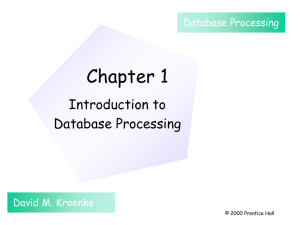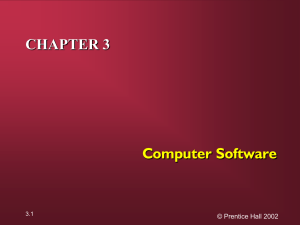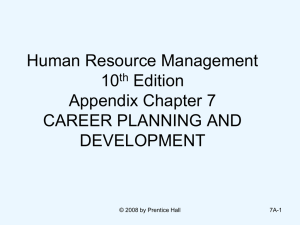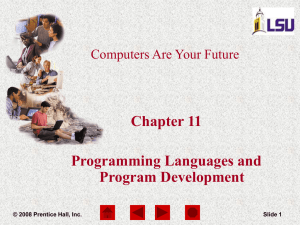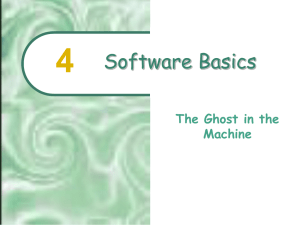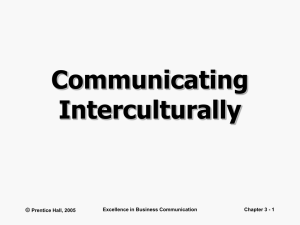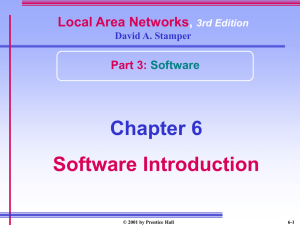Networks and Networking
advertisement
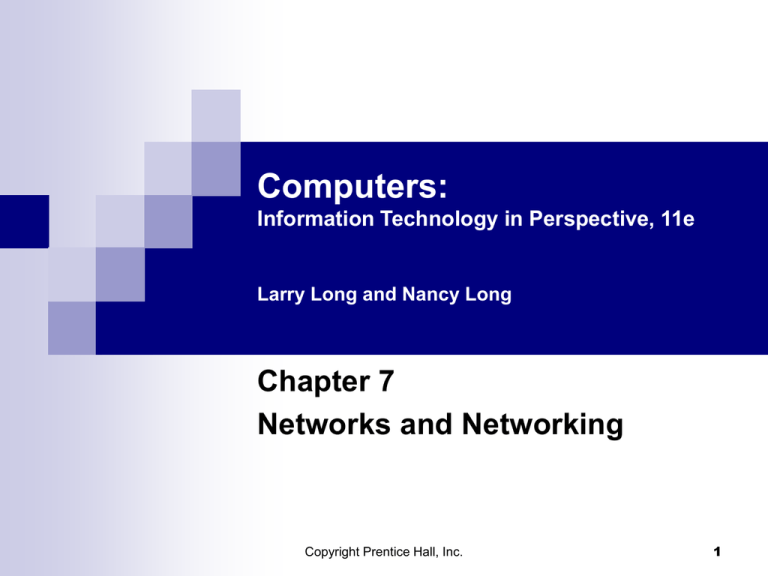
Computers: Information Technology in Perspective, 11e Larry Long and Nancy Long Chapter 7 Networks and Networking Copyright Prentice Hall, Inc. 1 Objectives Once you have read and studied this chapter, you will have learned: How the application of the concept of connectivity is affecting your life. Alternatives and sources of data transmission services that have enabled the networking of our world. The function and operation of data communications hardware. The various kinds of network topologies, essential local area network concepts and terminology, and the scope and potential of home networking. Copyright Prentice Hall, Inc. 2 Why this chapter is important to you! Learning about data communications and networking before going online will save you both time and money Learning about networks is not just for the office anymore; more and more homes are being networked everyday Understanding about networks can save a lot of frustration Copyright Prentice Hall, Inc. 3 Our Wired World Understanding information technology trends will help people cope with our increasingly wired society People are knowledge workers by day By night, people surf the Internet Copyright Prentice Hall, Inc. 4 Digital Convergence Everything is becoming digitally compatible: DVDs Telephones Televisions Computers Newspapers College courses Textbooks on CD-ROM Banking/Finance Copyright Prentice Hall, Inc. 5 Connectivity Connectivity means: Accessing information from one department to the next Sharing a printer Communicating with suppliers Sending a holiday newsletter via e-mail Networking your home Copyright Prentice Hall, Inc. 6 The Era of Cooperative Processing Internally (for company resources) via Intracompany networking Intranets Externally (for world competition) via Intercompany networking Business-to-business (B2B) E-commerce (electronic commerce) Extranets VPS Tunneling Copyright Prentice Hall, Inc. 7 The Data Communications Channel A communications channel is the medium through which digital information must pass Same as line, link, or pipe Requires special hardware that transmits the digital information between computers Copyright Prentice Hall, Inc. 8 Transmission Media: Twisted-Pair Wire Twisted-pair wire contains two insulated copper wires twisted around each other One twisted-pair line provides POTS Plain old telephone service: analog line that permits voice service Another service is DSL Digital subscriber line Copyright Prentice Hall, Inc. 9 Transmission Media: Coaxial Cable Coax: the cable in “cable television” Minimum signal distortion Has a very wide pipe Hundreds of times faster than POTS 100 times faster than ISDN Need a cable modem Copyright Prentice Hall, Inc. 10 Transmission Media: Wireless Communication Carries data via microwave or radio signals Transmission is line-ofsight Use transceivers/repeater stations Satellites Eliminates line-of-sight limitation Geosynchronous orbit set at 22,300 miles above earth Copyright Prentice Hall, Inc. 11 Transmission Media: Without Wires Wireless transceivers between PCs Alternative to running twistedpair, coax, or fiber optics Hooks into USB, PCI, or PCMCIA slot Limited range about 50 feet Use omnidirectional radio waves Limited channel capacity Copyright Prentice Hall, Inc. 12 The Future of Wireless Multichannel Multiport Distribution Service (MMDS) Local Multiport Distribution Service (LMDS) Wireless at fiber opticlevel speeds Will provide Internet service at 1 G bps Copyright Prentice Hall, Inc. 13 Transmission Media: Fiber Optic Cable Carries data as lasergenerated pulses of light Foundation transmission medium for Internet backbone Better for data security Future technology looks like very big “pipe” Copyright Prentice Hall, Inc. 14 Common Carriers AT&T, MCI, Sprint, etc. Private Line Leased Line Switched Line Dialup Line Copyright Prentice Hall, Inc. 15 Controlling Transmissions over Communications Channels Communication protocols Rules that govern the way data are transmitted TCP/IP (Transmission Control Protocol/Internet) Protocol Copyright Prentice Hall, Inc. 16 Asynchronous and Synchronous Asynchronous Transmission Low speed Modem needed Transmitted as needed Start/stop bits used Synchronous Transmission High speed Source and destination in “synch” No start/stop bits needed Copyright Prentice Hall, Inc. 17 Data Communications Hardware Data communication hardware is used to transmit digital information There are many devices that enable data communication Copyright Prentice Hall, Inc. Concentrators Hubs Bridges Routers Brouters NIC Modems And more… 18 The Standard Telephone-Link Modem Modulator-demodulator Converts digital signals to analog signals for transmission over phone lines Internal and external Usually a voice/data/fax modem Copyright Prentice Hall, Inc. 19 Other Modems Cable modem Supports cable Internet DSL modem High-speed Internet connection using fiberoptic cable Copyright Prentice Hall, Inc. 20 Network Interface Cards Allows exchange of data via a LAN Copyright Prentice Hall, Inc. 21 Routers Hardware and software used to ease the problems of linking incompatible networks Routes messages to proper destinations Backbone is a system of routers and transmission media that link computers Copyright Prentice Hall, Inc. 22 Terminals Enables both input and output from a remote computer system Dumb and smart terminals Examples: VDT (hospitals and airports) Windows terminals Telephone terminals Special function (ATMs) Copyright Prentice Hall, Inc. 23 Networks Networks are about sharing and communicating Networks allow printers, data, Internet access, and more to be shared Copyright Prentice Hall, Inc. 24 Network Topologies Network topology is a description of the possible physical connections within a network It is a configuration of hardware and it shows which pairs of nodes can communicate Copyright Prentice Hall, Inc. 25 Network Topology - Star Uses Category 5 cable (cat 6 is on the way) Cat 5 cable uses an RJ-45 connector for the NIC card Easy to install/not that expensive Computers are concentrated into a star pattern using hubs or switches Hubs broadcast data to all devices Switches can be used instead of hubs Switches can help segment data traffic but are more expensive If there is a break in the cable it does not disturb the other computers Copyright Prentice Hall, Inc. 26 Network Topology - Ring Uses different hardware More expensive Complex to install Data is passed around the ring until it reaches its destination Best at passing data with less collisions Copyright Prentice Hall, Inc. 27 Network Topology - Bus Least expensive/easiest to setup Uses coax cable Computers are daisy chained together in a linear bus Data packets are sent along the coax cables All computers hear data sent out A BNC connector is used for the NIC card Copyright Prentice Hall, Inc. 28 Types of Networks Local Area Network (LAN) Small network Usually confined to a building or an office floor Wide Area Network (WAN) Two or more LANs connected together The Internet is an example Metropolitan Area Network (MAN) Covers a large area, such as a city Copyright Prentice Hall, Inc. 29 LAN Overview One node at a time can send Transmission media Token access method Ethernet Twisted-pair, coax, and fiber optic LAN Servers File server Print server Communications Server Copyright Prentice Hall, Inc. 30 LAN Software Operating Systems Applications Software Peer-to-Peer LANs LANs with dedicated servers Client/Server Shared software Groupware Networks on the Fly Portable networks Copyright Prentice Hall, Inc. 31 Home Network Home networks are becoming more popular Home networks are typically peer-to-peer A router keeps track of all the computers inside the home network The computers are configured with fake IP addresses that allows them to communicate Setup for a home computer is fairly easy Copyright Prentice Hall, Inc. 32 Summary Our Wired World The Data Communications Channel Data Communications Hardware Networks Copyright Prentice Hall, Inc. 33
